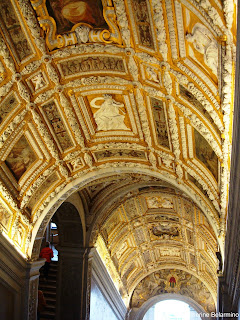Venice Beyond St. Mark’s Square
Grand Canal and Dome of Santa Maria della Salute |
Venice. That one word evokes romantic visions of canals, bridges, and gondoliers in striped shirts. Venice is on almost everyone’s bucket list. Unfortunately, most visitors only spend a few hours in Venice and rarely get to venture far beyond Piazza San Marco (St. Mark’s Square). During the day, the square is crowded with day trippers and cruise shippers. But even during these busy times, just a few streets outside of the square, the world opens up, and you can see the real Venice and feel far from the crowds. At night, when the crowds have left, the piazza feels like a different place. Venice was the third stop of our Italy trip, and we stayed three nights.
 |
| View from Our Room |
We traveled by train from Vernazza in the Cinque Terre through La Spezia and Bologna to Venezia (Venice). We left the train station and walked to the water and purchased our ACTV Tourist Travel Cards at a self-service ticket machine. If you plan on taking advantage of the waterbuses to get around, the travel card is an economical solution. They can be purchased to cover various time periods, from 12 hours to seven days, and allow unlimited travel. We hopped onto a waterbus with our luggage and started our time in Venice with a Grand Canal cruise on the way to our hotel. We stayed at the lovely Hotel Riva, an affordable hotel with 18th century styling and a canal view within the historical center.
To not spoil our first impression of Venice, we wanted to avoid the insane crowds on our first day, which we already had dragged our luggage through to get to our hotel, so we grabbed another waterbus and crossed the Grand Canal to Santa Maria della Salute. After exploring the church, we walked to the Gallerie dell’Accademia, a museum with a rich collection of Venetian paintings. We then crossed over the Ponte Dell’Accademia, from which there are breathtaking views of the Grand Canal and the impressive dome of Santa Maria della Salute. In the evening, after the city emptied, we visited St. Mark’s Square and listened to the outdoor cafes’ dueling orchestras.
The next morning we started our day at the Palazzo Ducale (Doge’s Palace). First we picked up our Museum Passes at the group counter. The Museum Pass is a great money saver, which can be ordered online, and grants free entrance to multiple museums in Venice, as well as Murano and Burano. Next we visited Basilica San Marco (St. Mark’s Basilica). You can skip the line if you use the bag check. There is a strictly enforced dress code; no shorts or bare shoulders. Next we visited the Museo Civico Correr (Correr Museum) across the square, also free with the Museum Pass.
We ended our day of sightseeing early because we had tickets to see Rigoletto at the Teatro La Fenice. The very first performance of Rigoletto was at the Teatro La Fenice in 1851. The version we saw was modernized. Attending a performance at this theater was absolutely awe inspiring. It felt like we had stepped back in time. The theater was first built in 1792. It has been the victim of two fires, but was rebuilt in the style of the original, and is very ornate with five levels of box seats. I have always wanted to sit in box seats at the theater, and this was the fulfillment of that wish.
 |
| Teatro La Fenice |
On our last day we started by taking the waterbus to San Giorgio Maggiore, a church on an island. There is a lovely view of Venice from the top of the church’s bell tower. We headed back across the water and visited Ca’ Rezzonico, free with the Museum Pass. Ca’ Rezzonico should not be missed. It is a grand palazzo built in the 17th century and beautifully decorated in the style of the 18th century with huge chandeliers, painted ceilings, and Venetian artwork by the likes of Canaletto, my husband’s favorite artist. We walked through the streets of Venice admiring the small canals and bridges. Venice is a beautiful city to enjoy on foot. It was also very interesting seeing boats delivering different things to shops, including produce. We traversed Campo Santa Margherita to the Scuola Grande di San Rocco, another striking building with an ornate upper hall. Mirrors are provided to view the frescoed ceilings and to save you from neck pain. Just across the way is Santa Maria Gloriosa dei Frari, a church with works of art by Giovanni Bellini, Titian, and Donatello, and an unusual pyramid tomb.
 |
| Produce Boat (above) View of One of the Small Canals (left) |
We had decided not to pay for an expensive gondola ride, so we chose the inexpensive option of taking a traghetto across the water to the Ca’ d’Oro, an art gallery that was our last stop. A traghetto is a gondola used to ferry passengers for a short trip across the Grand Canal and costs 0.50 Euro. It is a good way of experiencing a gondola for very little money. After the Ca’ d’Oro we walked back to our hotel, stopping at the Ponte di Rialto (Rialto Bridge).
I used Rick Steves’ Best of Europe and Fodor’s Venice’s 25 Best to plan this portion of our trip.
| Traghetto |
 |
| Ponte di Rialto (Rialto Bridge) |
 |
| Gondolas Docked on the Canal at Sunset |






